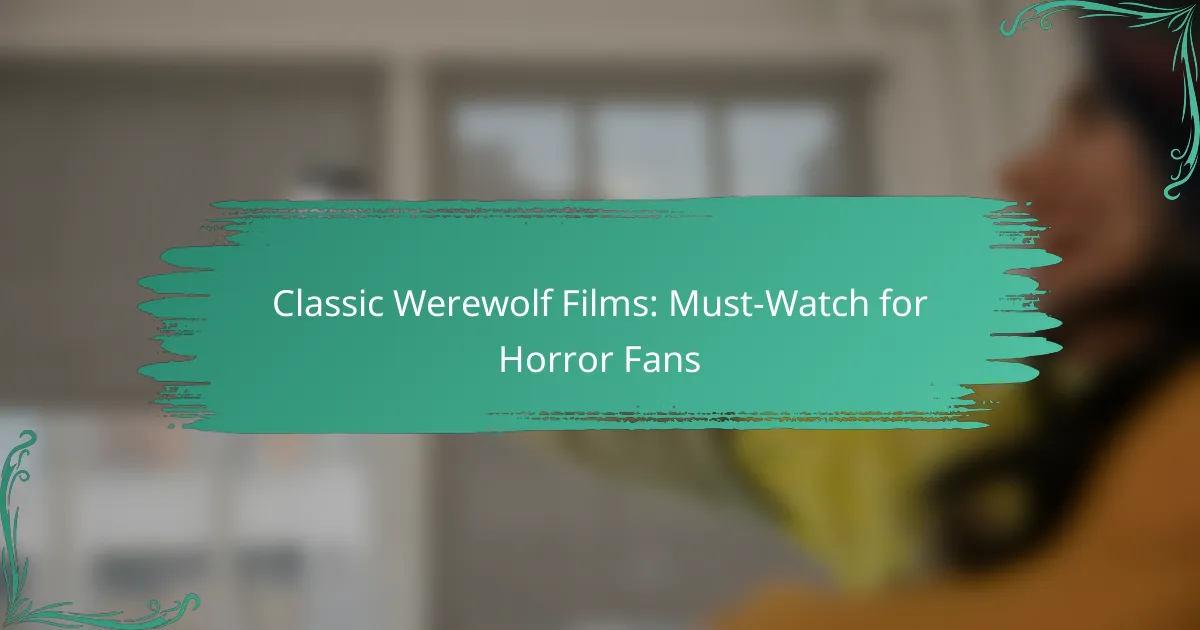Classic werewolf films are a cornerstone of horror cinema, capturing the chilling essence of lycanthropy through compelling storytelling and iconic transformations. These films not only entertain but also delve into profound themes of duality, isolation, and the primal instincts that lurk within humanity, making them a must-watch for any horror aficionado.
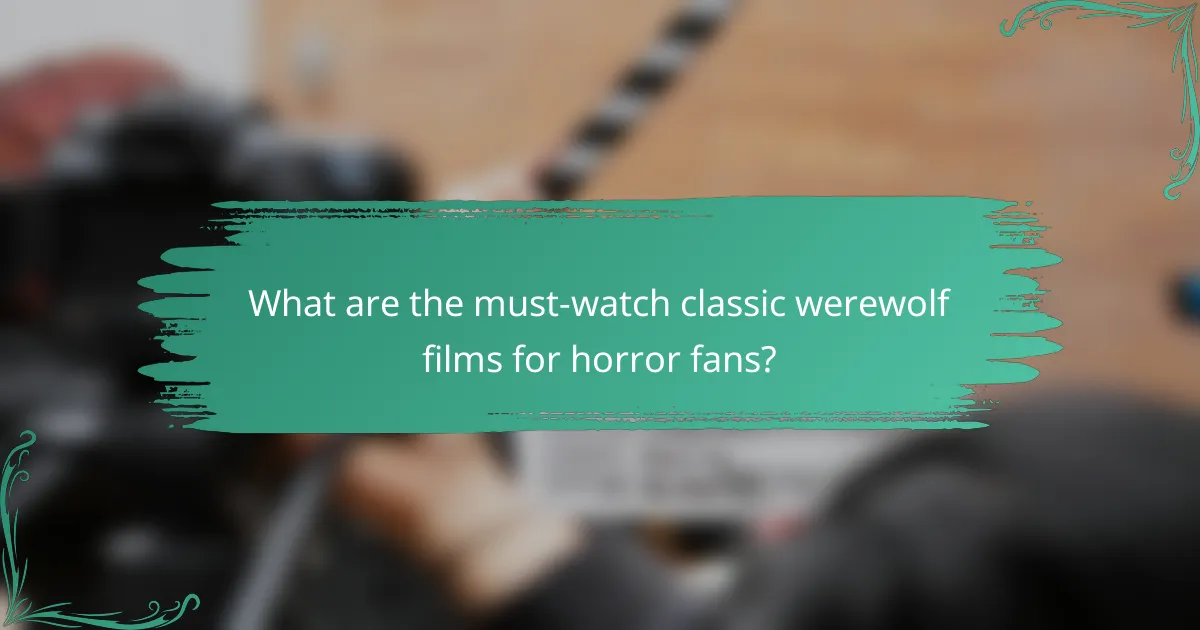
What are the must-watch classic werewolf films for horror fans?
Classic werewolf films are essential for horror enthusiasts, showcasing the transformation and terror associated with lycanthropy. These films blend folklore with cinematic storytelling, offering a mix of suspense, drama, and iconic transformations that have defined the genre.
The Wolf Man (1941)
“The Wolf Man” is a seminal werewolf film that set the standard for many future entries in the genre. Starring Lon Chaney Jr., it tells the story of Larry Talbot, who becomes cursed after being bitten by a werewolf, leading to a struggle between his humanity and the beast within.
This film is notable for its atmospheric cinematography and haunting score, which enhance the sense of dread. Its influence can be seen in countless werewolf films that followed, making it a must-watch for any horror fan.
American Werewolf in London (1981)
“American Werewolf in London” is a groundbreaking film that blends horror with dark comedy, telling the story of two American backpackers who encounter a werewolf in the English countryside. The film is celebrated for its innovative special effects, particularly the transformation scene, which remains iconic.
This film combines humor with genuine scares, making it a unique entry in the werewolf genre. Its critical acclaim and cult status ensure it remains a favorite among horror aficionados.
Dog Soldiers (2002)
“Dog Soldiers” is a British horror film that follows a group of soldiers on a training mission in the Scottish Highlands, who encounter a pack of werewolves. This film is notable for its intense action sequences and practical effects, which create a visceral experience.
The blend of military camaraderie and horror elements sets “Dog Soldiers” apart, offering a fresh take on the werewolf mythos. Its cult following highlights its effectiveness in delivering thrills and chills.
Ginger Snaps (2000)
“Ginger Snaps” is a unique take on the werewolf narrative, focusing on the transformation of a teenage girl, Ginger, as she undergoes both physical and emotional changes. The film cleverly uses lycanthropy as a metaphor for adolescence and the struggles of growing up.
This Canadian film stands out for its strong character development and feminist themes, making it relevant beyond typical horror tropes. Its blend of horror and dark humor resonates with many viewers, solidifying its status as a classic.
Silver Bullet (1985)
“Silver Bullet,” based on a Stephen King novella, tells the story of a small town plagued by a series of brutal murders attributed to a werewolf. The film features a young boy in a wheelchair who, along with his sister, uncovers the truth behind the creature terrorizing their community.
This film combines elements of family drama with horror, creating a compelling narrative. Its memorable characters and suspenseful plot make “Silver Bullet” a noteworthy addition to the werewolf genre.
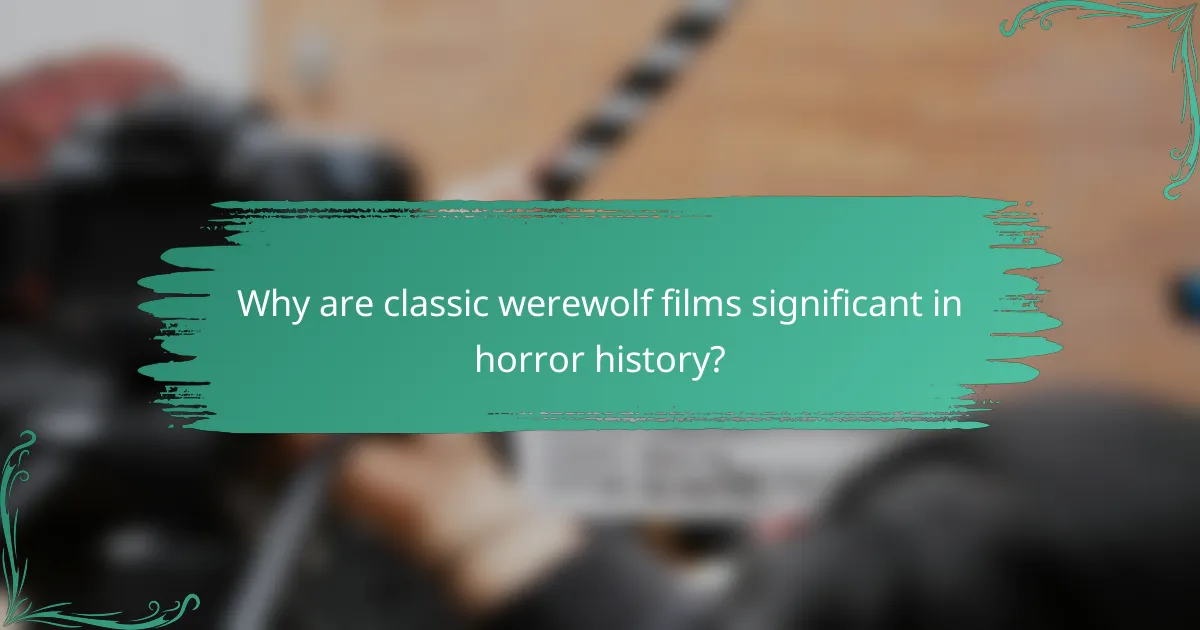
Why are classic werewolf films significant in horror history?
Classic werewolf films are significant in horror history because they explore themes of transformation, duality, and the primal instincts within humans. These films have shaped the genre by introducing iconic characters and tropes that continue to influence modern horror storytelling.
Influence on horror genre
Classic werewolf films have laid the groundwork for many horror subgenres, particularly those involving supernatural transformations and the struggle between humanity and monstrosity. Films like “The Wolf Man” have established key elements such as the cursed protagonist and the full moon as a trigger for transformation.
These films have inspired countless remakes and adaptations, showcasing the enduring appeal of werewolf lore. Their influence can be seen in contemporary horror films that blend psychological elements with supernatural themes, creating a rich tapestry of storytelling possibilities.
Cultural symbolism of werewolves
Werewolves symbolize the conflict between civilization and primal instincts, representing the fear of losing control to one’s darker nature. This duality resonates across cultures, often reflecting societal anxieties about identity and transformation.
Additionally, werewolves can embody themes of alienation and the struggle for acceptance. In many narratives, the werewolf’s transformation serves as a metaphor for adolescence or the challenges of fitting into societal norms, making these stories relatable on multiple levels.
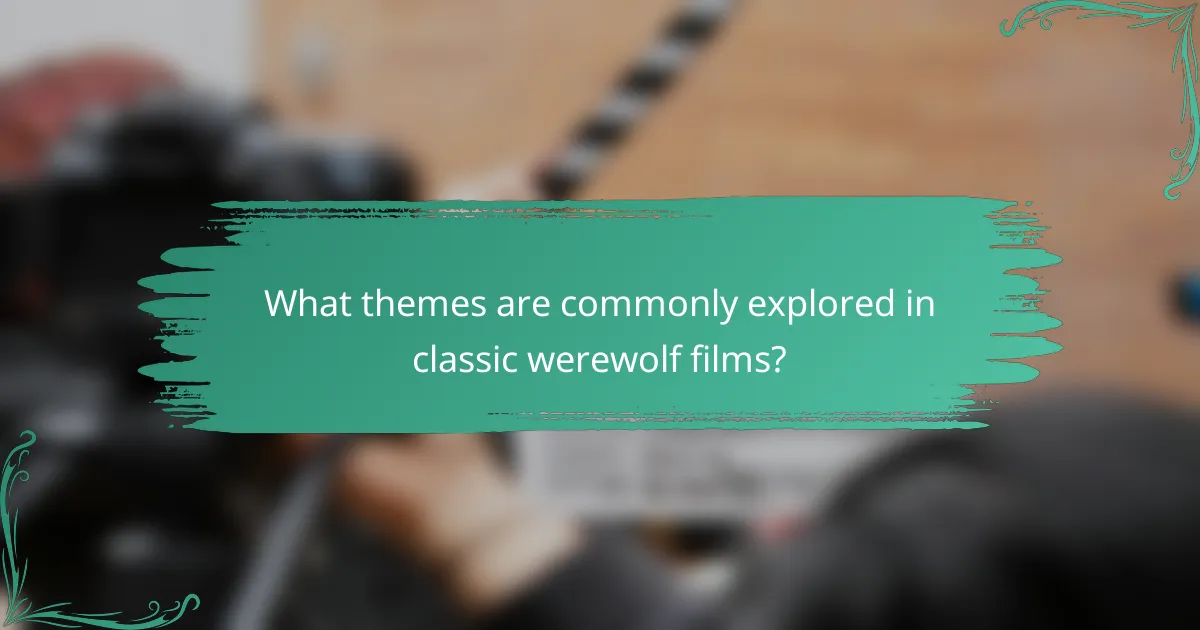
What themes are commonly explored in classic werewolf films?
Classic werewolf films often delve into themes of transformation, isolation, and the struggle between humanity and monstrosity. These narratives explore the psychological and physical changes that accompany the werewolf curse, highlighting the fear and alienation experienced by the afflicted.
Transformation and identity
Transformation is a central theme in werewolf films, symbolizing the struggle between one’s human nature and primal instincts. Characters often undergo a physical metamorphosis that reflects their internal conflicts, leading to questions about identity and self-control.
This theme is exemplified in films like “The Wolf Man,” where the protagonist grapples with his dual identity, torn between his human life and the beast within. The transformation serves as a metaphor for personal struggles, such as addiction or mental illness, making the horror relatable.
Isolation and fear
Isolation is another prevalent theme, as characters often find themselves cut off from society due to their condition. This sense of alienation amplifies the fear of the unknown, both from within and from the outside world, as others react with suspicion and dread.
In many classic films, the werewolf’s transformation leads to a loss of connection with loved ones, creating a poignant narrative of loneliness. The fear of being hunted or misunderstood adds to the tension, making the werewolf a tragic figure rather than just a monster.
Human vs. monster dichotomy
The struggle between human and monster is a defining conflict in werewolf films, illustrating the thin line between civility and savagery. Characters often face moral dilemmas that force them to confront their darker impulses, raising questions about what it means to be truly human.
This dichotomy is vividly portrayed in films like “An American Werewolf in London,” where humor and horror intertwine, showcasing the protagonist’s battle against his monstrous side. The tension between these identities serves to engage audiences, prompting reflection on their own humanity and moral choices.
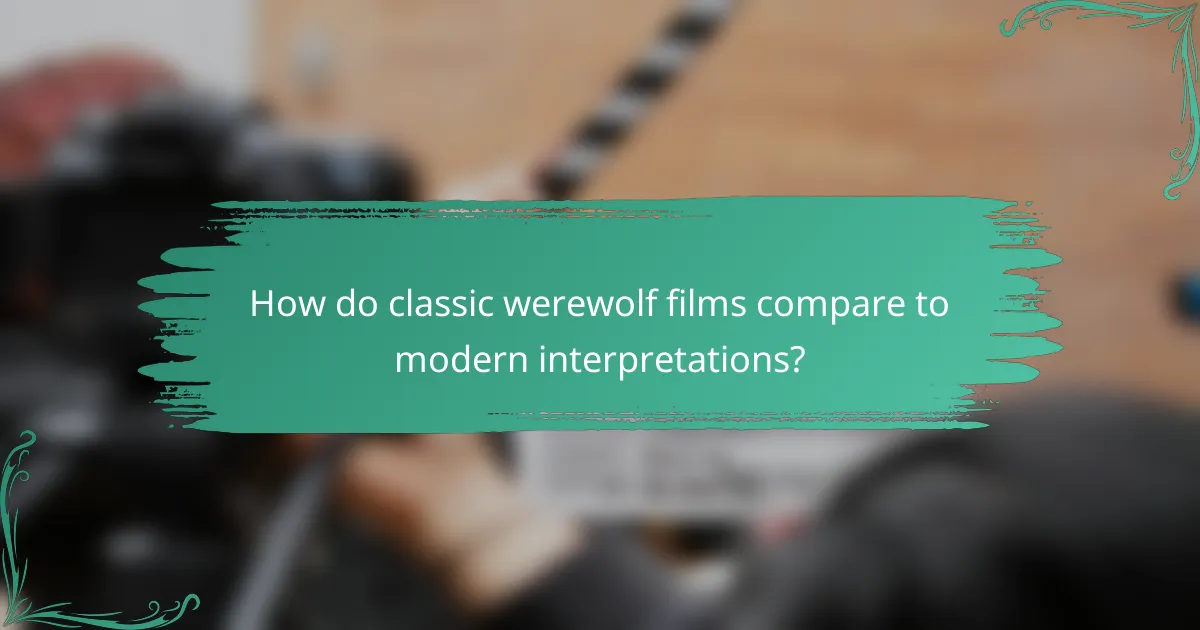
How do classic werewolf films compare to modern interpretations?
Classic werewolf films often emphasize practical effects and straightforward narratives, while modern interpretations leverage advanced CGI and complex storytelling. This evolution reflects changing audience expectations and technological advancements in filmmaking.
Visual effects evolution
Classic werewolf films relied heavily on practical effects, such as makeup and animatronics, to create their creatures. Films like “The Wolf Man” (1941) showcased transformation scenes that were groundbreaking for their time but limited by technology.
In contrast, modern films utilize CGI to create more realistic and dynamic werewolf transformations. This shift allows for more intricate designs and fluid movements, enhancing the overall visual experience. However, some fans argue that this can detract from the tangible horror that practical effects provide.
Narrative complexity
Classic werewolf films typically followed a straightforward plot, focusing on the curse of lycanthropy and its consequences. The narratives often centered around themes of isolation and the struggle between human and beast.
Modern interpretations tend to explore deeper psychological and social themes, incorporating elements like identity crisis, morality, and societal fears. This complexity can lead to richer storytelling but may alienate viewers who prefer the simplicity of earlier films.
Audience reception changes
Classic werewolf films were generally well-received for their innovative effects and engaging stories, appealing to audiences seeking thrills and chills. The cultural context of the time, including post-war anxieties, influenced their themes and popularity.
Today, audience reception varies widely, with some viewers embracing the nostalgia of classic films while others favor the more sophisticated narratives of modern adaptations. The rise of streaming platforms has also changed how audiences engage with horror, allowing for a broader exploration of the genre.
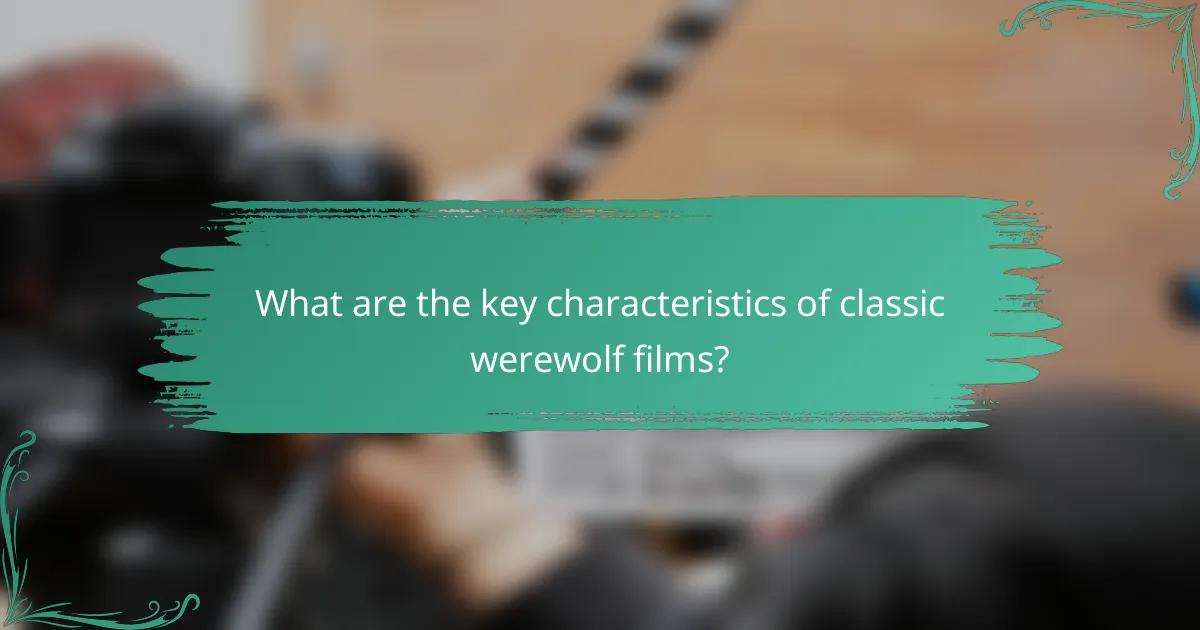
What are the key characteristics of classic werewolf films?
Classic werewolf films typically blend horror with themes of transformation and the struggle between human nature and primal instincts. Key characteristics include the portrayal of the werewolf mythos, character archetypes, and atmospheric settings that evoke fear and suspense.
Mythology and folklore roots
The origins of werewolf mythology can be traced back to various cultures, with tales of shape-shifting beings appearing in European folklore, Native American legends, and beyond. These stories often depict the werewolf as a cursed individual, highlighting themes of duality and the loss of control.
Classic films often draw from these rich traditions, incorporating elements such as full moons, silver bullets, and the struggle against one’s inner beast. This connection to folklore adds depth and authenticity to the narrative, resonating with audiences familiar with the legends.
Character archetypes
In classic werewolf films, character archetypes often include the tragic hero, the skeptic, and the innocent victim. The tragic hero is usually the protagonist who grapples with their transformation and the moral implications of their actions, while the skeptic often dismisses the supernatural elements until faced with undeniable evidence.
These archetypes serve to create tension and conflict within the story, as characters navigate their fears and relationships. The innocent victim often represents the collateral damage of the werewolf’s curse, heightening the stakes and emotional impact of the narrative.
Setting and atmosphere
The setting in classic werewolf films plays a crucial role in establishing a sense of dread and suspense. Dark forests, small towns, and isolated cabins are common backdrops that enhance the feeling of vulnerability and danger. The use of lighting, sound effects, and cinematography further amplifies the eerie atmosphere.
Filmmakers often utilize the contrast between the serene beauty of nature and the lurking threat of the werewolf to create tension. This juxtaposition not only captivates the audience but also reinforces the themes of transformation and the primal instincts that lie beneath the surface of civilization.
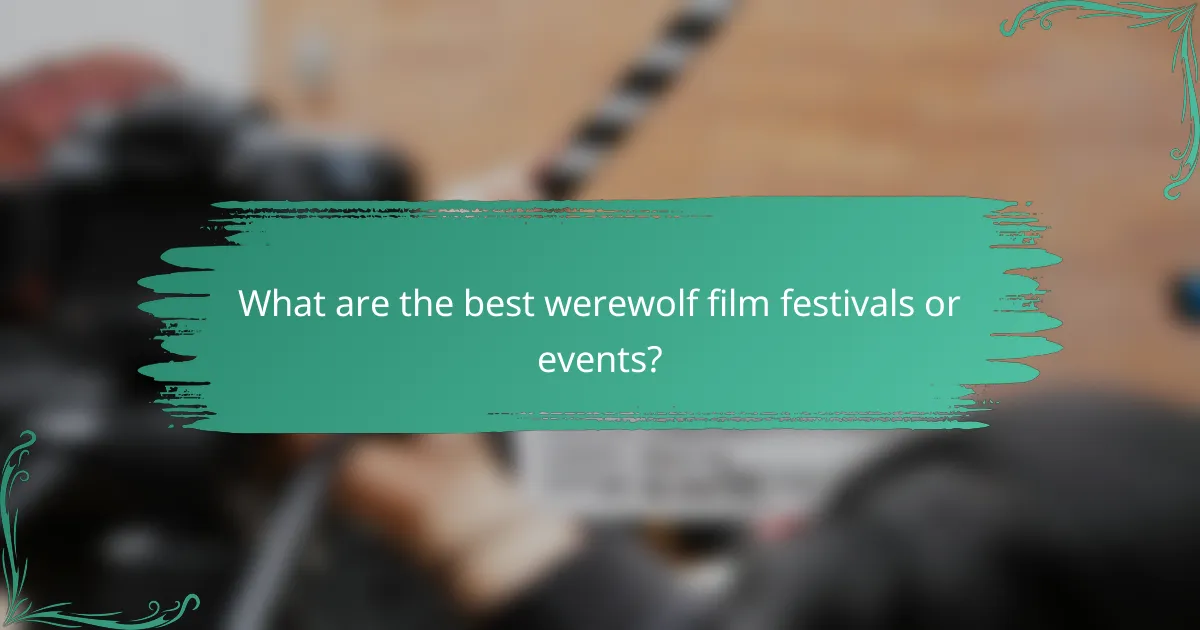
What are the best werewolf film festivals or events?
For enthusiasts of werewolf films, several festivals showcase horror cinema, including werewolf-themed features. These events provide a platform for filmmakers and fans to celebrate and explore the genre.
London FrightFest Film Festival
The London FrightFest Film Festival is a premier event in the horror film calendar, typically held annually in August. It features a diverse selection of horror films, including a notable focus on werewolf narratives, allowing fans to experience new releases and classic favorites.
Attendees can enjoy screenings, panel discussions, and Q&A sessions with filmmakers and actors. It’s a great opportunity to network with fellow horror enthusiasts and discover emerging talent in the genre.
Fantasia International Film Festival
The Fantasia International Film Festival, held in Montreal, Canada, is renowned for its eclectic mix of genre films, including horror and fantasy. This festival usually takes place in July and often includes a variety of werewolf films, showcasing both international and local talent.
Participants can expect a vibrant atmosphere with film screenings, workshops, and special events. The festival is known for its supportive community, making it an excellent venue for filmmakers to present their work and for fans to engage with the genre.
